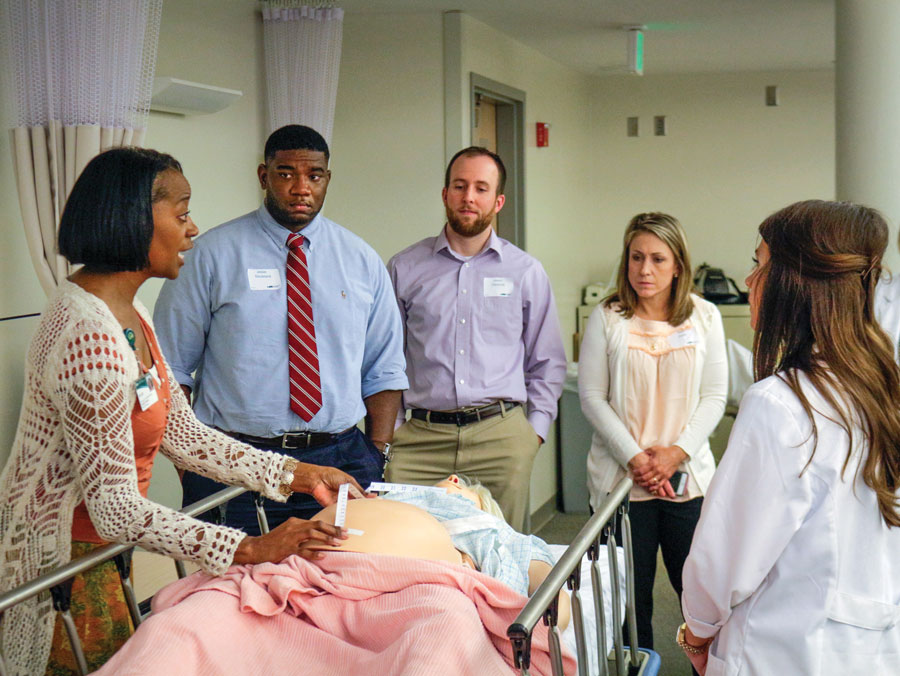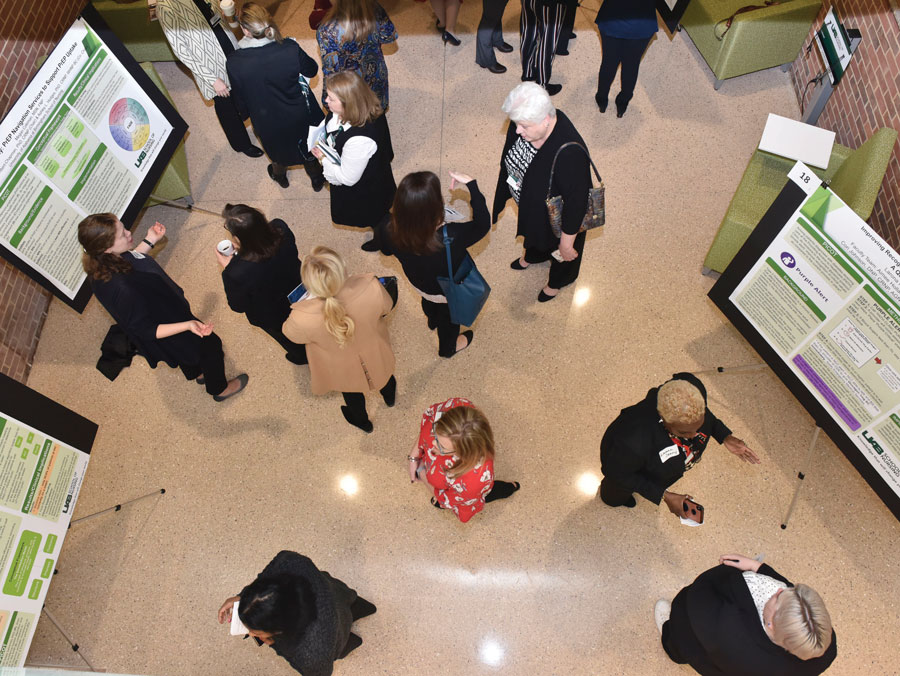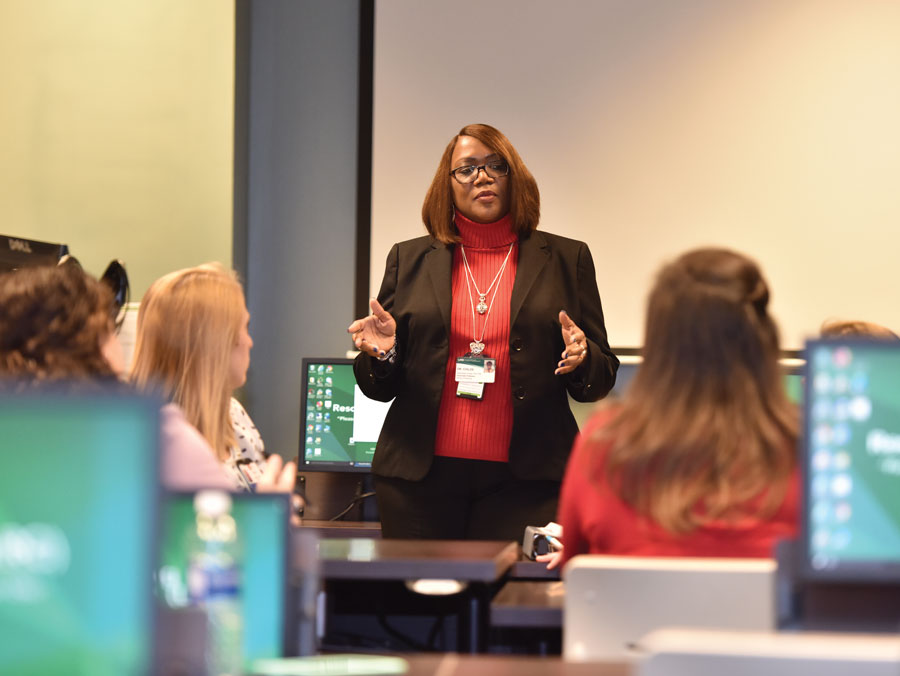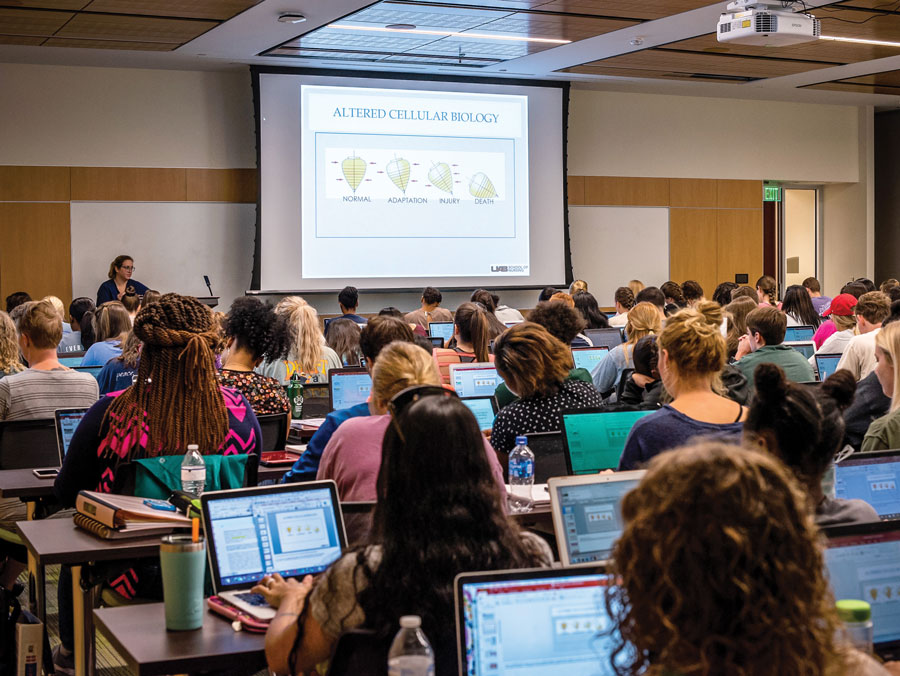 The University of Alabama at Birmingham School of Nursing has been long recognized for its, high-quality academic programs. They are on the cusp of the latest trends in education, but undergo continuous evaluation and improvement, integrate the latest technologies and provide the most up-to-date clinical knowledge available using breadth and depth of faculty expertise and the latest scientific discoveries. Students benefit from interprofessional faculty and nurse leaders who are trailblazers in education, clinical practice and research, and who anticipate the future needs of health care and how nursing can best meet those needs. And, graduates have an academic foundation that encourages lifelong learning, whether they are at the bedside, in the boardroom or teaching in the classroom.
The University of Alabama at Birmingham School of Nursing has been long recognized for its, high-quality academic programs. They are on the cusp of the latest trends in education, but undergo continuous evaluation and improvement, integrate the latest technologies and provide the most up-to-date clinical knowledge available using breadth and depth of faculty expertise and the latest scientific discoveries. Students benefit from interprofessional faculty and nurse leaders who are trailblazers in education, clinical practice and research, and who anticipate the future needs of health care and how nursing can best meet those needs. And, graduates have an academic foundation that encourages lifelong learning, whether they are at the bedside, in the boardroom or teaching in the classroom.
Early decisions set up the UAB School of Nursing for success, and generations of students continue to benefit from partnerships, technology integration, research breakthroughs and dedicated faculty born of those decisions. It’s also those decisions that have helped position the School for top U.S. News & World Report academic program rankings—seventh in the nation among public schools of nursing in academic health systems for master’s degrees and 10th for Doctor of Nursing Practice degrees. Among specialties, the Master’s in Nursing Administration is first in the nation among public schools of nursing, the Master’s Family Nurse Practitioner is fourth and the Doctor of Nursing Practice Family Nurse Practitioner is second for 2021.
“The actions of our early deans laid the foundation for where we are today,” said Senior Associate Dean for Academic Affairs Linda Moneyham, PhD, RN, FAAN. “The very first dean, Florence Hixson, moved the nursing program from Tuscaloosa to Birmingham, putting the School on the ground floor of what would become UAB. That was incredibly influential because it brought baccalaureate and higher degree education to Birmingham, allowing nursing to work with our health care colleagues. These collaborations and alignments with medicine and others helped set the tone for the excellence for which our School is known today.”
Purposeful Programs
Thoughtful planning and recognition of emerging trends in health care have guided the School of Nursing through deliberate expansion over the past 15 years to meet the needs of one of the most severe nursing shortages seen in history while also providing a top-tier, highly ranked education.
 During the tenure of Dean and Fay B. Ireland Endowed Chair of Nursing, Doreen C. Harper, PhD, RN, FAAN, the School built upon Dean Rachel Booth’s foundation to add a fourth degree program , growing from three to more than a dozen graduate specialty tracks, and streamlining pathways to bachelor’s, master’s and doctoral degrees to create a seamless transition from prelicensure to doctoral programs. In 2008, another new academic option became a reality in the Accelerated Master’s in Nursing Pathway (AMNP), a pathway designed specifically for individuals with a bachelor’s degree or higher in a non-nursing field, that has placed nearly 700 new highly educated nurses into the workforce since its inception. Additionally, in 2018, the School partnered with local community colleges that offer Associates Degrees in Nursing to provide a joint ADN to BSN pathway program for highly qualified students, enabling them to stay closer to home and access a high-quality, affordable baccalaureate education in a timely way.
During the tenure of Dean and Fay B. Ireland Endowed Chair of Nursing, Doreen C. Harper, PhD, RN, FAAN, the School built upon Dean Rachel Booth’s foundation to add a fourth degree program , growing from three to more than a dozen graduate specialty tracks, and streamlining pathways to bachelor’s, master’s and doctoral degrees to create a seamless transition from prelicensure to doctoral programs. In 2008, another new academic option became a reality in the Accelerated Master’s in Nursing Pathway (AMNP), a pathway designed specifically for individuals with a bachelor’s degree or higher in a non-nursing field, that has placed nearly 700 new highly educated nurses into the workforce since its inception. Additionally, in 2018, the School partnered with local community colleges that offer Associates Degrees in Nursing to provide a joint ADN to BSN pathway program for highly qualified students, enabling them to stay closer to home and access a high-quality, affordable baccalaureate education in a timely way.
Retired Senior Associate Dean for Academic Affairs Elizabeth Stullenbarger, DSN, RN, worked in the mid-2000s to overhaul the School’s graduate education curriculum to ensure programs were competitive and able to nimbly respond to the flux in the health care market. This included establishing new specialty tracks, creating a more unified view of the graduate program and expanding distance-accessible education opportunities.
“As a School, I believed we had a national mission. I saw us as part of a bigger picture—serving the country as well as the state and region,” Stullenbarger said. “Throughout the School’s history, our deans kept that goal and that bigger mission in mind, creating innovative programs and expanding opportunities for students.”
More new pathways and specialties are on the horizon—a new Dual DNP/PhD Pathway and a revived Nurse Midwifery Pathway are next.
“As we develop programs and pathways, we focus on the question of, ‘How are we going to achieve health equity for everyone?’” Harper said. “In developing the Dual PhD/DNP Pathway, we wanted to integrate clinically focused experts and their depth of specialty knowledge and expertise into research so that findings are most relevant to populations in need and are translated as quickly as possible. By offering the dual pathway we also can reduce time to completion and not duplicate classes or effort, thereby creating a seamless pathway to degree progression.
“Bringing back the Nurse Midwifery graduate specialty is something we have been planning for several years,” she continued. “With our School’s focus on population health, our Nurse Family Partnership, and the health disparities and inequities experienced by women and children and magnified by the COVID-19 pandemic, bringing back this specialty will positively improve access and impact the health of mothers and babies in Alabama.”
The School’s continued dedication to a diverse workforce and student body is aligned with the goal of achieving health equity across all populations. The School supports multiple organizations that promote diversity and inclusion in nursing and health care, including local chapters of the National Black Nurses Association Inc., American Association of Men in Nursing, National Association of Hispanic Nurses and Philippine Nurses Association of America, to help increase the number of diverse, highly trained nurses prepared at the baccalaureate level or higher to help improve access to and quality of care provided to increasingly complex patients, especially those in medically underserved populations.
The impact of the COVID-19 pandemic has further emphasized the importance of a nursing education centered on diversity, inclusion and equality. Two-time UAB School of Nursing alumna and Associate Professor Martha Dawson, DNP, RN, FACHE, is President of the National Black Nurses Association, Inc. and said that “throughout 2020, the disproportionate impact of COVID-19 on Black and Hispanic communities highlights the need for nursing to reflect the populations they serve. As individuals and groups with a role in these communities, nurses can better understand unique population needs regarding health care, education and resources.”
“In order to educate, you need to have cultural sensitivity and awareness about how to best educate individuals,” Dawson said.
These organizations also provide vital career-building resources such as mentorship and networking opportunities, scholarships and others, and their efforts receive recognition on a national level. The Birmingham Chapter of the American Association of Men in Nursing, recently revitalized by UAB School of Nursing faculty, was named a 2019 and 2020 Best School for Men in Nursing, recognizing significant efforts in recruiting and retaining men into the nursing profession.
“It is important to knock down the perceived barriers and boundaries in nursing,” said UAB School of Nursing alumnus, AAMN Birmingham Chapter board member and Assistant Professor Curry Bordelon, DNP, MBA, CRNP, CNE, NNP-BC, CPNP-AC. “The diversity of ideas and experiences ultimately improves the care we can provide and gives insight into nursing in the real world.”
“No one has all of the answers to the issues we face in terms of health disparities and inequalities,” Harper said. “Working with these organizations brings a diverse perspective and resources to prepare a nursing workforce that can manage the health care needs of a diverse community.”
Continuous evaluation of curriculum is an ongoing process to ensure the needs of diverse populations are represented. New student groups at all levels also are providing feedback to ensure the needs of diverse populations are met in the learning process.
“Ensuring we are constantly revising and adjusting curriculum to address factors of social justice and health equity is crucial for meeting student and patient needs today and planning for future,” Harper said. “It is our job to take care of all populations and as our curriculum changes go forward our goal is to set standard for diversity, equity and inclusivity in the curriculum to improve health equity, reduce health disparities and address the health care needs of all people.”
Distance Education Leadership
 The UAB School of Nursing has always been on the leading edge of academics, as early adopters of distance-accessible learning opportunities.
The UAB School of Nursing has always been on the leading edge of academics, as early adopters of distance-accessible learning opportunities.
“Some of our earliest faculty, including Dr. Jean Kelley, took on the mission of preparing nurses beyond the baccalaureate degree to be nurse educators because there was such a need,” Moneyham said. “They recognized that it was not enough to teach students in the classroom—they needed to go out into the community to be able to prepare more nurses to meet community health needs and withstand the demand for nursing faculty to continue to support baccalaureate-prepared nurses.”
“Throughout our School’s history, you can see the School rising to the occasion and providing new opportunities for nurses,” Harper added. “That has continued as we develop new pathways, especially in our distance-accessible education options for all graduate programs. Kudos to Dean Rachel Booth and her colleagues for their forward-thinking approach in laying the foundation for distance accessible programs shortly after the turn of the 21st century.”
Since 2005 the School has used strategic grant writing to exponentially grow distance education through $46 million in Health Services and Resources Administration (HRSA) grants to establish educational programs related to rural health, population health, behavioral health integration. Currently a four-year, $2.8 million grant is helping to improve health outcomes in medically underserved areas in Alabama and to educate undergraduate nursing students and practicing RNs in team-focused primary care with an emphasis on chronic disease prevention and control in diabetes, high blood pressure, mental health and substance use disorder. It created new academic-practice partnerships in medically underserved areas in Jefferson, Etowah and Macon counties.
In Macon County, the School also has joined forces with the Tuskegee University School of Nursing and Allied Health as an affiliate partner for the program. Other HRSA-funded programs include a three-year, $1.5 million grant to incorporate behavioral health in nurse-managed clinics, and a four-year, $2.8 million grant to advance addiction care and education for advance practice nursing students.
“These community-based grants enable us to fill gaps in care and meet a rising need for mental health care. The growth in distance-accessible graduate education also helps answer our question ‘How are we going to achieve health equity?’ and meet one of the looming needs in health care — highly skilled providers in rural areas who are able to understand and meet health care needs, integrate behavioral health and incorporate the social determinants of health into care,” Harper said. “We continue to be able to serve so many students who otherwise might not be able to leave their families and jobs to move to Birmingham and enroll in studies totally based in our building, and this helps keep nurses in their communities to meet health care needs of our medically underserved populations.”
Today, Harper said, the School continues to look at expansion of distance accessible and telehealth programs, especially those around health equity.
“These additions and changes center on factors that have exacerbated health inequities, including COVID-19, and how we can impact those in a positive way,” she said.
Community Needs
 While the UAB School of Nursing has grown in its student population, it also has grown in new options designed to meet the unique needs of a changing health care landscape and to tackle health care disparities. This included a focus on nurse practitioner education at the close of the 20th century, under Dean Rachel Booth, and a continued expansion under Dean Harper’s tenure that advocates for expanded scope of practice and opportunity for advanced practice nurses.
While the UAB School of Nursing has grown in its student population, it also has grown in new options designed to meet the unique needs of a changing health care landscape and to tackle health care disparities. This included a focus on nurse practitioner education at the close of the 20th century, under Dean Rachel Booth, and a continued expansion under Dean Harper’s tenure that advocates for expanded scope of practice and opportunity for advanced practice nurses.
“All of the different specialties offered at the graduate level have arisen because there has been a need,” Moneyham said. “The first NP programs focused on a general ‘nurse practitioner’ in order to fill gaps in care, reach more populations and to provide the patient-centered care nurses are recognized for. Over time, it has evolved as different types of needs have arisen where nurses in specialty areas can provide high-quality care and improve outcomes.”
The UAB School of Nursing’s graduate clinical programs now offer nearly a dozen nurse practitioner specialties, including women’s health, psych/mental health, adult primary and acute care, pediatric primary and acute care available to Master of Science in Nursing and Doctor of Nursing Practice students. Subspecialties such as palliative care, emergency care, forensics, population health and transitional care also offer even further advanced specialization, Associate Dean for Graduate Clinical Education Ashley Hodges, PhD, CRNP, WHNP-BC, FAANP, said, allowing graduates to follow their passions and find their best fit in the profession.
“We have nurse practitioner options, nursing and health care leadership options, informatics, and we offer further specialization,” Hodges said. “It’s exciting to see all of this increased specialization, as well as increased utilization and expansion we are closing gaps in care and getting health care to rural and medically underserved populations.”
The School has consistently worked with its on-campus and community partners to understand and meet health system and community needs, especially in the ongoing integration of behavioral health across undergraduate and graduate programs. The multiple grant-funded initiatives to develop behavioral health integration protocols in the School’s graduate programs and nurse-managed clinics also are benefiting undergraduate students. As students complete clinical hours or residencies within these clinics, they are able to better understand and apply tools used to recognize substance and alcohol misuse, mental health and other conditions.
“Faculty are continually working to identify new clinical experiences by networking with clinical partners in the community and acute care settings. As a result, students have had opportunities to engage in telehealth and COVID-19 triaging and notification experiences,” said Associate Dean for Undergraduate and Prelicensure Education Gwendolyn Childs, PhD, RN, FAAN.
A focus on pathways for nurse leaders across health care administration is also preparing graduates to have a seat at the table when decisions that impact health care and nursing on a large scale are made. While all programs integrate communications skills and an understanding of evidence-based care, leadership pathways such as the DNP for Nurse Executives provide tools to be a highly engaged and active nurse leader.
“Nurses have the knowledge and understanding of health systems and patient care, but they also need the skills to speak up to influence and advocate for decisions to improve and health care,” Moneyham said. “That’s why we’re dedicated to developing new roles and pathways to train nurses to be informaticians, executives and population health experts who can lead in health systems and hospitals, to do a better job of caring for people.”
Moving Forward
“Keeping up with current trends in strategies for enhancing clinical experiences creates engaging opportunities for students, and ensures they are prepared to care for patients across different life and clinical circumstances,” Childs said.
One trend that is growing because of COVID-19 and will remain is telehealth. It’s been used to maintain social distancing with health care providers and to link families to hospitalized and critically ill loved ones during COVID, but in places like Alabama with stark health disparities and inequities that limit access to primary and specialty care, telehealth provides critical care to patients within their homes and it is important for nurses at all levels to be familiar with the technology, that is why students are trained on it at the undergraduate and graduate levels.
“Telehealth is the future for how many people will receive their care,” said Associate Professor Tedra Smith, DNP, CRNP, CPNP-PC, CNE, who teaches telehealth-centered content at the School. “It is important for our students to be familiar with telehealth equipment and the proper way to deliver care through telehealth because its use will continue to grow.”
Another continually growing area students are being trained in is community collaboration for health care delivery.
“We have partnerships in the community with health care systems and clinics that care for medically underserved populations. We’re currently building a partnership with a charter school where pediatric faculty and students can provide care to students,” Moneyham said. “All of these elements come together to create a much stronger learning experience for students. If they get to see firsthand how they have helped a community; it changes how they see their job and potential impact on all patients.”